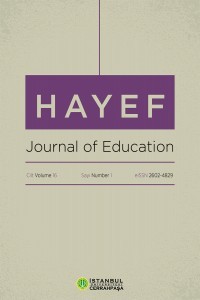İlişki Ağı Envanteri Kısa Formu’nun Türkçe Uyarlama Çalışması
İlişki Ağı Envanteri, anne ilişkileri, arkadaş ilişkileri, geçerlik, güvenirlik
Turkish Adaptation Study of the Network of Relationships Inventory-Short Form
Network of Relationships Inventory, mother relations, friend relations, validity, reliability,
___
- Argyle, M., & Lu, L. (1990). The happiness of extroverts. Personality and Individual Differences, 11, 1011–1017.
- Aydın, D. (1999). Social network composition, social support and psychological well-being in first METU students: A longitudinal investigation. (Yayınlanmamış Yüksek Lisans Tezi, Orta Doğu Teknik Üniversitesi, Sosyal Bilimler Enstitüsü, Ankara).
- Burk,W. J., & Laursen, B. (2005). Adolescents perceptions of friendship and their association with individual adjustment. International Journal of Behavioral Development, 29(2), 156-164.
- Büyüköztürk, Ş. (2002). Faktör analizi: Temel kavramlar ve ölçek geliştirmede kullanımı. Kuram ve Uygulamada Eğitim Yönetimi, 32, 470-483.
- Carbery, J., & Buhrmester, D. (1998). Friedship and need fulfillment during three phases of young adulthood. Journal of Social and Personal Relationships, 15, 393-408.
- Cüceloğlu, D. (1993). İnsan ve davranışı. İstanbul: Remzi Kitabevi.
- Diener, E., Emmons, R. A., Larsen, R. J., & Griffin, S. (1985). The satisfaction with life scale. Journal of Personality Assessment, 9(1), 71-75.
- Fanti, K. A., Henrich, C. C., Brookmeyer, K. A., & Kuperminc, G. P. (2008). Toward a transactional model of parent and adolescent psychological adjustment. Journal of Early Adolescent, 28(2), 252-276.
- Fuligni, A. J., & Eccles, J. S. (1993). Perceived parent-child relationships and early adolescents' orientation toward peers. Developmental Psychology, 29, 622-632.
- Furman, W., & Buhrmester, D. (1985). Children's perceptions of the personal relationships in their social networks. Developmental Psychology, 21, 1016-1022.
- Furman, W., & Buhrmester, D. (2010). Network of Relationships ouestionnaire manual. (Unpublished manuscript).
- Gençöz, T. (2000). “Pozitif ve negatif duygu ölçeği: Geçerlik ve güvenirlik çalışması”, Türk Psikoloji Dergisi, 15(46) 19-28.
- Gümüşten, D. (2013). Algılanan ekonomik güçlük ile benlik saygısı ve yaşam doyumu arasındaki bağlantıda anne-ergen ilişkilerinin aracı rolü. (Yayımlanmamış Yüksek Lisans Tezi, Ankara Üniversitesi, Ankara.)
- Gürcan, D. (2015). Perceived parental relationship, self-discrepancy, and personality characteristics in relation to psychological well-being. (Yayımlanmamış Doktora Tezi, Orta Doğu Teknik Üniversitesi, Ankara).
- Haller, M., & Hadler, M. (2006). How social relations and structures can produce happiness and unhappiness: An international comparative analysis. Social Indicators Research, 75, 169-216.
- Hortaçsu, N. (2012). İnsan ilişkileri (4. bs.). Ankara: İmge KitabeviYayınları.
- Lee, A., Hankin, B. L., & Mermelstein, R. J. (2010). Perceived social competence, negative social interactions, and negative cognitive style predict depressive symptoms during adolescence. Journal of Clinical Child & Adolescent Psychology, 39(5), 603-615.
- Morgan, M. L., Vera, E. M., Gonzales, R. R., Conner, W., Vacek, K. B., & Coyle, L. D. (2011). Subjective well-being in urban adolescents: Interpersonal, individual, and community influences. Youth &Society 43(2), 609-634.
- Myers, D. G. (1993). The pursuit of happiness. New York: Avon Books.
- Oppenheimer, C. W., & Hankin, B. L. (2011). Relationship quality and depressive symptoms among adolescents: a short-term multiwave investigation of longitudinal, reciprocal associations. Journal of Clinical Child & Adolescent Psychology, 40(3), 486-493.
- Reis, H. T., Capobianco, A., & Tsai, F. F. (2002). Finding the person in personal relationships. Journal of Personality, 70(6), 813-844.
- Say, G. (2016). Problemli internet kullanımı ile ilgili bazı değişkenler: Ebeveyn-ergen ilişki niteliği, yalnızlık, öfke ve problem çözme. (Yayımlanmamış Yüksek Lisans Tezi, Ankara Üniversitesi, Ankara.)
- Schwarz, B., Trommsdorff, G., Albert, I., & Mayer, B. (2005). Adult parent-child relationships: relationship quality, support, and reciprocity. Applied Psychology, 54(3), 396-417.
- Sullivan, H.S. (1953). The interpersonal theory of psychiatry. New York: Norton & Co.
- Sümer, N. (2000). Yapısal eşitlik modelleri: Temel kavramlar ve örnek uygulamalar. Türk Psikoloji Yazıları, 3(6), 49-74.
- Tabachnik, B. G., ve Fidell, L. S. (2015). Çok değişkenli istatistiklerin kullanımı (6. bs.) Mustafa Baloğlu (Çeviri Ed.). Ankara: Nobel Kitap.
- Valkenburg, P. M., & Jochen, P. (2007). Online communication and adolescent well-being: Testing the stimulation versus the displacement hypothesis. Journal of Computer-Mediated Communication, 12, 1169-1182.
- Van Horn, K. R., & Marques, J. C. (2000). Interpersonal relationships in Brazilian adolescents. International Journal of Behavioral Development. 24(2), 199-203.
- Veenhoven, R. (1999). Quality of life in individualistic society. Social Indicators Research 48, 157–186.
- Watson, D., Clark, L. A., & Tellegen, A. (1988). Development and validation of a Brief measure of positive and negative affect: The PANAS scales. Journal of Personality and Social Psychology, 54, 1063-1070.
- Weiss, R.S. (1974). The provisions of social relationships. In Z. Rubin (Ed.), Doing unto others (pp. 17-26). Englewood Cliffs, NJ: Prentice-Hall.
- Young, M. H., Miller, B. C., Norton, M.C., & Hill, E. J. (1995). The effect of parental supportive behaviors on life satisfaction of adolescent offspring. Journal of Marriage and the Family, 57, 813-822.
- Başlangıç: 2004
- Yayıncı: İstanbul Üniversitesi-Cerrahpaşa
3 Boyutlu Dijital Ortamda İngilizce Eğitimi
Yetişkin Eğitiminde Bir Öğretim Aracı Olarak Şiirin Rolü: Literatür Taraması Örneği
Çocuk Edebiyatında Toplumsal Cinsiyetsiz Karakterler: Bir Araştırma Örneği
Birey Yetiştirme Sürecinde Edebiyat Öğretiminin İşlevi: “Gülibik”, “Yaban” ve “İsa Bu Köye Uğramadı”
An Investigation into the Experiences of Erasmus Students
Öğretmenlerin Algılarına Göre İş Motivasyonu ve Örgütsel Özdeşleşme Arasındaki İlişki
Hakan Şevki AYVACI, Gürhan BEBEK
Türkiye'de Suriyeli Öğrencilerin Eğitimine Yönelik Okul Yöneticilerinin Görüşleri
